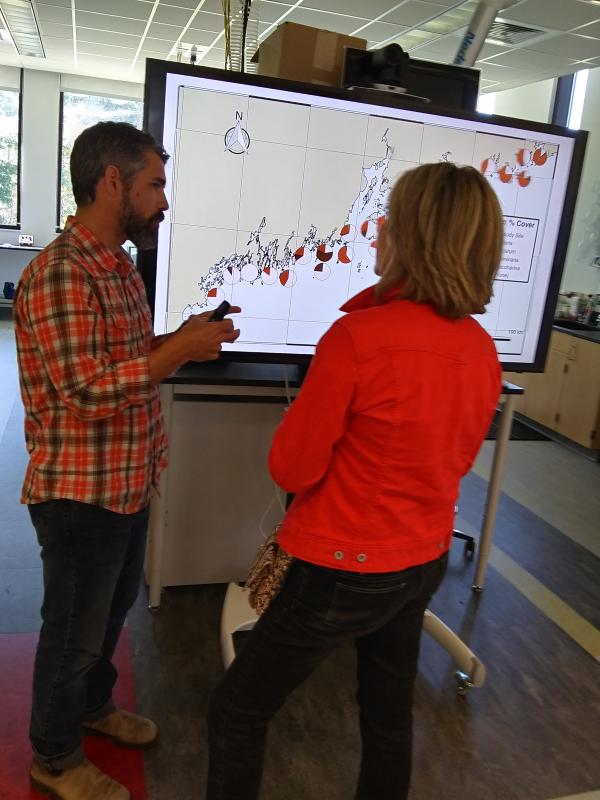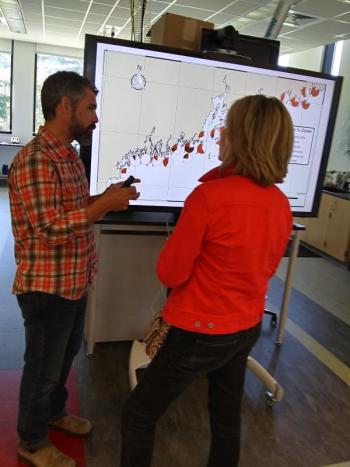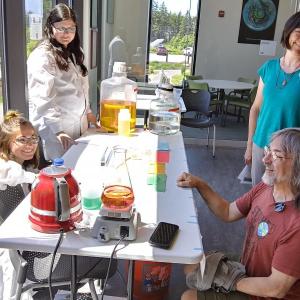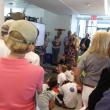Bigelow Laboratory hosts hundreds in open house
 From left, Bigelow Laboratory’s Kate Smith and Kristin Heidenreigh talk ocean science with visitors Renee and Michael Zeleny of Rice, Minnesota. JANE CARPENTER/Boothbay Register
From left, Bigelow Laboratory’s Kate Smith and Kristin Heidenreigh talk ocean science with visitors Renee and Michael Zeleny of Rice, Minnesota. JANE CARPENTER/Boothbay Register
 Guests at Bigelow Laboratory’s open house July 19 found any space available as they heard from scientists. JANE CARPENTER/Boothbay Register
Guests at Bigelow Laboratory’s open house July 19 found any space available as they heard from scientists. JANE CARPENTER/Boothbay Register
 Dr. Doug Rasher, senior research scientist, and Marige Bursaw, summer resident of Southport, discuss kelp forests. JANE CARPENTER/Boothbay Register
Dr. Doug Rasher, senior research scientist, and Marige Bursaw, summer resident of Southport, discuss kelp forests. JANE CARPENTER/Boothbay Register
 Members of Brunswick’s Outward Bound group hosted by Bowdoin College learn what happens at the open house’s “under pressure” exhibit. JANE CARPENTER/Boothbay Register
Members of Brunswick’s Outward Bound group hosted by Bowdoin College learn what happens at the open house’s “under pressure” exhibit. JANE CARPENTER/Boothbay Register
 From left, Bigelow Laboratory’s Kate Smith and Kristin Heidenreigh talk ocean science with visitors Renee and Michael Zeleny of Rice, Minnesota. JANE CARPENTER/Boothbay Register
From left, Bigelow Laboratory’s Kate Smith and Kristin Heidenreigh talk ocean science with visitors Renee and Michael Zeleny of Rice, Minnesota. JANE CARPENTER/Boothbay Register
 Guests at Bigelow Laboratory’s open house July 19 found any space available as they heard from scientists. JANE CARPENTER/Boothbay Register
Guests at Bigelow Laboratory’s open house July 19 found any space available as they heard from scientists. JANE CARPENTER/Boothbay Register
 Dr. Doug Rasher, senior research scientist, and Marige Bursaw, summer resident of Southport, discuss kelp forests. JANE CARPENTER/Boothbay Register
Dr. Doug Rasher, senior research scientist, and Marige Bursaw, summer resident of Southport, discuss kelp forests. JANE CARPENTER/Boothbay Register
 Members of Brunswick’s Outward Bound group hosted by Bowdoin College learn what happens at the open house’s “under pressure” exhibit. JANE CARPENTER/Boothbay Register
Members of Brunswick’s Outward Bound group hosted by Bowdoin College learn what happens at the open house’s “under pressure” exhibit. JANE CARPENTER/Boothbay Register
Bigelow Laboratory for Ocean Sciences is a quiet neighbor in East Boothbay, barely noticed as cars drive by. But to international scientists wrestling with issues that affect our planet, it’s a big name in world-class research.
On Friday, July 19, Bigelow Laboratory invited the public in for a visit. The open house pulled in 375 adults and children from Maine and away. The four-hour event gave the public a chance to meet some of Bigelow’s 90 employees, half of them Ph.D’s, and check out scientific demonstrations and activities.
Experts in each field shared their knowledge with an enthusiastic audience and children were as keen to participate as adults, often sitting on the floor in front of the scientists as they spoke.
Visitors heard about the National Center for Marine Algae and Microbiota, the largest and most diverse collection of marine phytoplankton in the world – all part of Bigelow.
Dr. Doug Rasher described the changing characteristics of kelp forests, urchin and crab populations in coastal Maine ecosystems. He said warming water temperatures have caused the lobstering industry – which used to reach as far south as New York – to steadily shift north over the last 30 years.
The open house also offered special exhibits and experiments. Guests could take samples of the Damariscotta River and see the live plankton under a microscope. Art activities included Design-a-Plankton and Ocean Life coloring. At the dock, visitors could use research equipment like a Secchi disk and a Niskin bottle.
From its local headquarters, the non-profit research institute sends scientists around the world. Bigelow was founded in 1974 by scientists Clarice and Charles Yentsch, who wanted to start a lab built by, run by and expressly for scientists. The current building in East Boothbay replaced an earlier Juniper Point headquarters in 2012.
As CEO and President Deborah Bronk explained, Bigelow is funded primarily by grants but 20 percent of its funds come from private donors.
The organization is looking to raise $16-18 million for a new wing that will be home to its administration as well as educational programs.
The research conducted at Bigelow impacts everyday non-aquatic life. Asked for examples, Bronk spoke about Bigelow’s work to make it affordable to feed farm-raised salmon a supplement of algae to replace some of the substances currently used for color.
Another research project is looking at a way to use algae to create chemicals instead of making them in factories. And a project with potentially immense global impact is looking at ways to reduce methane from cows (a major contributor to climate change) by substituting algae for their current feed.
Communications Director Steven Profaizer summed up the importance of the research facility’s work. “Marine algae provide half of the oxygen we breathe and form the base of the entire ocean food web. While often unseen, they have a tremendous impact on everyone’s lives.”
Scientists at Bigelow spend all their time on research. According to Bronk, that creates a staff “At the top of their game.”
Asked what she hopes the hundreds of visitors learned from the open house, she replied: “A couple of facts about the ocean and that scientists are accessible and normal people.”
To arrange a tour, contact 315-2567.
Event Date
Address
United States



























